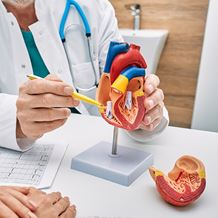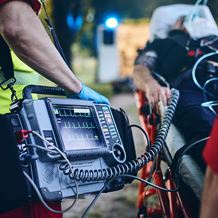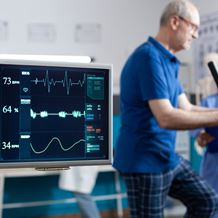
- Home
- Services
- Cardiac Services
- Recovery
- Pacemaker Placement (PPM) Recovery
Pacemaker Placement (PPM) Recovery
Pacemaker placement or implantation surgery is one of the most common types of heart procedures. The surgery is typically performed using a local anaesthetic and is generally considered to be low risk. This type of minimally invasive procedure means patients may experience a faster discharge and a quicker recovery time. The recovery will look different for each patient, and much of it will depend upon your age, health and wellbeing coming into the operation. Taking an active role in your own recovery is crucial to optimising the benefits of surgery, and our specialist rehabilitation team are here to support you at every step as you return to health and adjust to living with your pacemaker. Please ask about our dedicated cardio rehabilitation program that you can access through your hospital.
Home preparation for pacemaker placement
As your upper body movement will be restricted for a few weeks after surgery, it’s a good idea to make sure your home environment is prepared for your return. Leaving the security of the hospital environment can feel overwhelming at first, and it is completely normal to experience some emotional swings after surgery. There are some useful ways to prepare for your return home.
- Prepare some cooked meals in advance
- Arrange to have some help at home with daily tasks while you recover from surgery
- Set up a recovery area where you can rest and complete your daily rehabilitation exercises
- Organise some loose-fitting clothes to avoid aggravating the wound
- Keep all necessary items accessible and below hip height to avoid over-stretching
Your recovery from pacemaker placement surgery
After the surgery is complete, you will spend some time in recovery before being discharged. Some patients may be required to spend slightly longer in hospital, but patients are typically discharged one or two days after the procedure. It is normal to see a slight bulge under the skin where the pacemaker has been implanted, and there may be some bruising at the incision site which should go away after a few weeks. The wound is protected by a special dressing, and your doctor may recommend keeping your arm immobilised in a sling to help with your recovery while you heal. Although you are likely to be able to return to your usual routine within a few days, driving is not permitted until advised by your doctor and any strenuous activity should be avoided until cleared by your medical team. You will be given specific information about the make and model of your pacemaker, as well as any necessary precautions. Attending regular follow-up appointments as advised by your doctor is an important part of the recovery process, and essential to ensuring that your pacemaker continues to function effectively.
What to look out for at home
Talk to your medical team at once if you experience any of the following:
- Faintness or dizziness
- You feel an alarm or vibration from your pacemaker
- Redness or oozing around the wound site
- Fever
- Hiccups that last a long time
- Heart-related symptoms
Average recovery timeline
Week 1
- Keep your wound clean and dry
- Protect your wound if wearing a bra or seatbelt
- Keep your arm low, and avoid raising it above your shoulder until cleared by your doctor
- Avoid lifting heavy objects or any strenuous activity for the first six weeks
- Talk to your doctor about any pain
- Perform the prescribed rehabilitation exercises to prevent the shoulder stiffening up
Weeks 2-4
- Your doctor will check the wound site and remove the dressing
- Talk to your doctor about returning to work
- Short walks can gradually increase in distance as you return to strength
- By 4 weeks you should be back to normal activities and general household tasks
- Talk to your doctor about returning to driving
Weeks 4-6
- Your pacemaker is checked to ensure it is working properly
- Reaching above shoulder height may now be permitted by your doctor
- Start to build up your level of exercise
- Continue on with your prescribed physiotherapy exercises
Week 6 +
- The wound should now be fully healed
- Talk to your doctor about returning to sports with a push and pull action, such as golf or swimming
- Avoid any contact sports to protect your device
Regular follow-up care is required after pacemaker placement surgery. Patients are given a pacemaker ID card that will help other medical professionals administer any care that you need in the future.
Living with your pacemaker
Many patients feel anxious leaving hospital after pacemaker placement. This is completely normal and an expected part of the recovery process. When leaving hospital, your discharge team will talk to you about any precautions you need to consider:
- Always carry an ID card with the details of your pacemaker
- Avoid high-voltage machinery and equipment
- Inform your doctor or dentist prior to any surgery
- Avoid contact sport that could impact your pacemaker
- Inform airport security as your pacemaker may activate the alarm, and detector wands may affect the function of your device
- Always attend your scheduled check-up appointments
Pacemaker Placement Recovery FAQs
What's next?
If you have been experiencing heart-related symptoms, book an appointment with our cardiac services specialist today.
Our specialists in Cardiac Services
View all specialists
Related content

Cardiac Services
Cardiology services at St Vincent’s Private Hospitals, advanced cardiac care.
Read More
Heart Failure
A condition that develops when your heart is unable to pump enough blood around your body.
Read More
Recovery
Cardiac recovery and rehabilitation programs are designed to help you after surgery.
Read More

